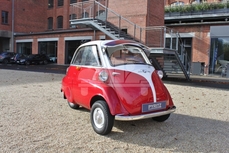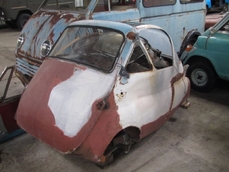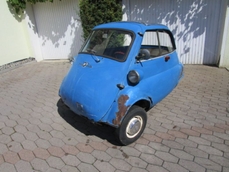BMW Isetta Coupe 1957
General description :
The world might have missed out on such legendary BMWs as the 3.0 CSL, M1, and M3 had it not been for an Italian appliance company named Isothermos. The loose connection between the mighty Bavarian automaker and Isothermos began in 1942 when by a young engineer and heir to an industrial fortune, Renzo Rivolta purchased Isothermos. Rivolta was passionate about all things petrol-powered, and he began to expand the company’s range, adding motorbikes to the portfolio, renaming the works Iso Autoveicoli S.p.A. After World War II, Europeans were desperate to get back on wheels, but with raw materials and fuel at a premium, few could afford a conventional car. Motorbikes and scooters became hugely popular, but they were impractical in bad weather or for anyone with a family. As a way to bridge the gap between bike and car, some manufacturers turned to motorbike-powered microcars that offered cheap, efficient, and practical transport for the masses.
Wanting to cash in on this new market, Renzo Rivolta began development of a 2-passenger microcar with a single front clamshell door, and a small capacity motorbike engine mounted amidships. Introduced in 1953, the Iso Isetta Turismo was the quintessential bubble car. It was adorable, it could transport two people and a few belongings, and it was highly efficient although not particularly quick thanks to having just 236cc and 9 ½ horsepower. It turned out to be reasonably successful in the home market, with 20,000 built at the Iso works in Milan.
Rivolta recognized a viable market for the Isetta; however, he lacked the manufacturing capacity to meet Europe-wide demand. Rivolta’s stroke of genius came in 1954 when he sold the rights to the design to several different companies in Europe and South America. Among those firms was BMW, who was struggling through the post-war recovery. Most of their factories were devastated by bombing, and their Eisenach works fell within Russian-controlled East Germany. BMW’s post-war product line consisted mainly of expensive six and eight-cylinder luxury cars that, while capable, had limited appeal in the post-war economy. Without the time and resources to develop a small car, the Isetta was the perfect opportunity to support the bottom line. Of course, they couldn’t help but to fettle with the design, modifying it to accept a 250 c.c. four-stroke engine shared with the R25/3 motorcycle and making minor styling changes. In 1956, BMW bumped the capacity to 298cc which gave the new Isetta 300 nearly one-and-a-half times the power output over the 250. With a storming 13 horsepower on tap, not even hills could stop BMW’s mighty-mouse! The Isetta continues to delight today’s collectors, and some of the most serious collections make room for the little German bubble car of outsized importance.
Offered here is an excellent example of BMW’s iconic Isetta microcar. This 1957 model wears a well-maintained older restoration, presented in two-tone Pastellblau and Bayerische Blau. The two-tone color scheme is a factory-offered livery, pleasingly finished and detailed with an array of period-correct details and accessories. Paintwork is in good order, with glossy and consistent surfaces, and a small touchup found here and there, upon close inspection. The fit of the clamshell front door is very good, and the body rubbers and minor trim are in excellent condition. Chrome is also excellent, with straight bumper bars and overrider tubes front and rear. The car rides on correct cream-colored steel wheels, shod with black wall tires and brushed alloy hubcaps.
With room for two passengers and a few groceries on the parcel shelf, the Isetta interior is cozy yet also refreshingly straightforward, with only the bare essentials needed for getting to and fro. Vinyl-covered panels line the body sides and inside of the door, and this example features a matching gray vinyl upholstered bench seat. Every Isetta features a sunroof, which also doubles as an exit should the front door become blocked. The sunroof vinyl cover and frame mechanism are in excellent working order. Controls and switchgear appear original and in similarly good condition throughout the interior.
The single-cylinder BMW motorbike engine runs very well, thanks to a recent service and carburetor tune. Access is easy thanks to a removable side panel, and the engine is clean and well-presented with proper finishes and fittings. The suspension and driveline are in similarly good order, and the car exhibits excellent road manners. With just 13 horsepower on tap, every drive in an Isetta is an adventure, and it is nearly impossible not to smile when stirring the 4-speed gearbox and listening to the little single-cylinder buzz of this well-sorted example. Despite its humble roots and diminutive size, the Isetta casts an outsized shadow over the history of the German motoring industry, saving BMW from certain takeover, and providing the storied firm its opportunity to continue on to greatness.
https://hymanltd.com/vehicles/6484
1957 BMW Isetta Coupe is listed sold on ClassicDigest in St. Louis by Mark Hyman for $32500.
Car Facts
Car type : Car Make : BMW Model : Isetta Model Version : Coupe Engine size : 0.0 Model Year : 1957 Sub type : Coupé Location : Missouri
Sold
Seller Information
Sold
People who viewed this BMW Isetta also viewed similar BMW listed at ClassicDigest
Other cars listed for sale by this dealer
About BMW
ChatGPT
Bayerische Motoren Werke, commonly known as BMW, has a rich history dating back to its founding in 1916. Initially established as an aircraft-engine manufacturer during World War I, BMW faced restrictions on aircraft production after the war. In response, the company shifted its focus to motorcycle production in 1923, marking the beginning of its involvement in the automotive industry. Subsequently, BMW entered the world of automobiles in 1928 by producing the DIXI, essentially a licensed version of the Austin 7 from the Austin Motor Company.
In the 1930s, BMW began to establish itself as a manufacturer of elegant and high-performance vehicles. One notable model from this era is the BMW 327, introduced in 1937. The 327 was available as both a coupe and a cabriolet, showcasing the brand's commitment to luxury and style. Additionally, BMW achieved success in sports car racing during this period, particularly with the BMW 328. The 328, which debuted in 1936, became renowned for its performance and aerodynamics. BMW campaigned the 328 in various racing events, including the prestigious Mille Miglia, where the company introduced several aerodynamic specials.
The post-war era proved challenging for BMW, and the company faced financial difficulties that nearly led to bankruptcy. However, BMW managed to recover and rebuild, eventually becoming one of the leading premium automotive brands globally.
As the 1960s unfolded, BMW further solidified its reputation for producing sports-oriented and luxurious vehicles. In 1968, the BMW 2002 was introduced, marking the birth of the "New Class" of compact, sporty sedans. The 2002 gained popularity for its agile handling and performance, laying the foundation for BMW's sporty image.
Moving into the 1970s, BMW expanded its lineup with the introduction of the E9 platform, which included the iconic BMW 3.0 CS coupe. The E9 series showcased BMW's commitment to blending performance and luxury. In 1972, the M1, BMW's first mid-engined sports car, made its debut. The M1 was initially developed as a racing car but later became a road-going model. The M1 laid the groundwork for BMW's high-performance M series.
In the late 1970s, the BMW E24 6 Series was introduced, offering a combination of luxury and performance. The 6 Series included models like the 630CS, 633CSi, and 635CSi, becoming a symbol of sophistication and driving pleasure.
Through these milestones and a commitment to innovation and performance, BMW has evolved into a powerhouse in the automotive industry, maintaining its status as one of the leading premium brands worldwide.











